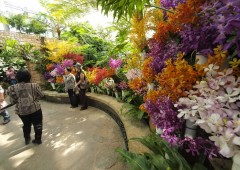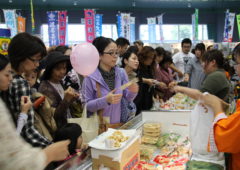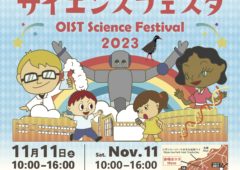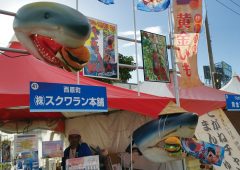2014.05.03
Sustainable development, English ability is key to future
By E. Heinrich-Sanchez
 At Love, Play, Learn you will find hundreds of ideas for children’s activities, toddler activities, arts and crafts, sensory play, pretend play, outdoor play, family activities, traditions, parenting advice, and book suggestions and activities. http://www.loveplayandlearn.com
At Love, Play, Learn you will find hundreds of ideas for children’s activities, toddler activities, arts and crafts, sensory play, pretend play, outdoor play, family activities, traditions, parenting advice, and book suggestions and activities. http://www.loveplayandlearn.com
We need to live and prosper without compromising this ability for future generations. In today’s “super-size” society, we are getting bigger and consuming more. Recycling technology is still decades behind the scope of the problems we face today. On nuclear energy in a Mainichi Newspaper article about Koizumi’s visit to Germany, “It’s been said that nuclear power is like “an apartment without a toilet,” http://mainichi.jp/english/english/perspectives/news/20130826p2a00m0na008000c.html
The pursuit of happiness is the dream of all on the planet. We are being surrounded by our refuse. The reality is that we need to start looking for another planet. In the meantime, we need to find ways to live here on Earth, this island in space, as long as we can. Un-checked growth is a blueprint for implosion. Wikipedia defines cancer as: “…unregulated cell growth. In cancer, cells divide and grow uncontrollably”. According to the UNESCO, sustainable development is defined as: “meeting the needs of the present without compromising the ability of future generations to meet their own needs. This vision of development embraces environmental concerns as well as issues such as the fight against poverty, gender equality, human rights, cultural diversity, and education for all.”http://www.unesco.org.uk/education_for_sustainable_development
From Okinawa, in order for us to connect regionally and globally, English language is a key that has the potential to unlock opportunities in business while opening the doors to other cultures. English is also the official language of science. I encourage ALL teachers in Okinawa to connect to the UNESCO Associated Schools website and join us in the last year of the Japan motivated United Nations Decade on Education for Sustainable Development.
The easiest way to dive into the world of English is to invite it into your home by reading to your kids. For those who are stationed here in Okinawa, volunteering to read books at local elementary schools goes a long, long way. This works the other way around too, for those who want to learn Japanese. A great tool that can go both ways and works for older kids and adults is the “Hiragana Times”. Use it for Japanese but Japanese can use it as an interesting supplement to their English material. http://www.hiraganatimes.com/
The American Chamber of Commerce in Okinawa’s (ACCO) Education Committee has sponsored several book drives. The drive has been successful in bringing “real” English books to local elementary schools and libraries. I say “real” as these books do not have the limited phonetic Japanese KATAKANA script next to the English, and are books, which are popular in the US and other English speaking countries. Next week, we will feature an update on the ACCO’s efforts for improving English education in Okinawa.
If English is not your first language, I have found that families enjoy a CD book at bedtime. This works for international families where one spouse might be learning English as well. Plug in the CD player next to the bed and read along with your child. These books are available at Tuttle Book store at Plaza House along with a great selection at your local BX/PX and on-line. It is just a matter of making the time. The stories can be reinforced by playing in the car to and from day care or school. Pre-school and Kindergarten is the best age for this as kids are hyper focused on language and do not mind repetition.
I am looking for a story along the lines of “Cinderella meets Einstein”. How to catch these young hyper-focused minds and invite them to the curious and wonderful world of math and how it intertwines with music and nature. From the Fibonacci numbers found in spirals and everywhere to the magic of the number 9, I would love to find materials that my kids can color and use to learn the basic ABC’s while raising their science awareness as a matter of fact.
Language is sound. Music is sound. Music is Math. How to connect these parallels in fun ways? English has more sounds than the Japanese language. Helping our children be able to listen and imitate a wide range of sounds will help them in their future efforts for language learning. Like the TV or radio jingles that stay in your head all day, easy songs are an excellent tool.
One other idea is to keep track of your child’s development by starting a blog. This week, I would like to introduce a great blog I found, “Love, play and learn”. It rings like the movie title “Eat, Pray, Love” starring Julia Roberts. This blog stars Brittany’s daughter Isabella. http://www.loveplayandlearn.com/about
Please share with us your ideas. In any reading program, please refere to the official Ministry of Education, Culture, Sports, Science and Technology (MEXT) guidelines on the use of “KATAKANA”.
According to the MEXT “Practical Handbook for Elementary School English Activities” published in 2001 (ISBN978-4-304-04078-8 C3037 by Karyudo 16th edition Feb.2008), It recommends in “Chapter 3: What Kinds of Teaching Methods Exist”?” the following* from page 143-144 under 3. Teaching Precautions (1) Do Not Translate Everything into Japanese. (2) Do Not Pronounce English Words Using Katakana Sounds (3). Do Not Force Students to Memorize (4) Do Not Correct Small Mistakes (5) Apply Various Learning Formats, No Only Whole-Class Lessons.
I would like to focus on No.(2) and challenge all JU readers who want to see Okinawa become competitive in the Asia-Pacific to perk up their musical ears and imitate English sounds for what they are as best as they can. Language is sound. Music is sound. Let’s get our musical talents to enhance the learning and mastery of English with a focus on “COMMUNICATION” and fun.
“(2) Do Not Pronounce English Words Using Katakana Sounds:
The problem with rendering English sounds with katakana is that English sounds cannot be truly represented with katakana. When katakana is used to represent English sounds, the sounds rendered are different from what is heard – a vowel sound will end each syllable, accents will be the same as in Japanese, etc. – and students will remember incorrect sounds. After taking such great efforts to expose students to “Assistant Language Teachers” (ALT native speakers) pronunciation, teachers should not use katakana to spell out what has been said. Elementary school English activities center around spoken English, with almost no time spent on reading. Consequently, it is unlikely that students would try to render English in katakana. When students try to do so, it is probably to help themselves remember what they have learned. In such cases, it is very important to reassure students that forgetting is not a problem, that they will naturally remember expressions as they use them again and again, and that undue efforts to memorize expressions are unnecessary.”
Comments welcome to info@japanupdate.com

 2024.04.26
2024.04.26 2024.04.22
2024.04.22 2024.04.10
2024.04.10 2024.01.31
2024.01.31 2024.01.02
2024.01.02 2023.12.27
2023.12.27 2023.11.16
2023.11.16 2023.11.14
2023.11.14 2023.11.10
2023.11.10 2023.10.26
2023.10.26






